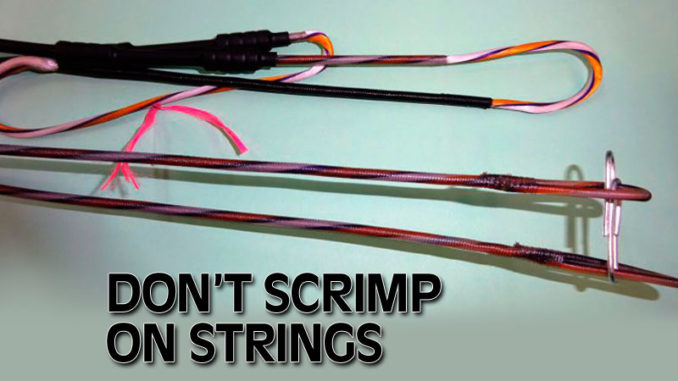
Strings, cables play a big role in accuracy
Many components make up modern compound bows, and the string system is one of the most important. The string and cables on today’s bows are the equivalent of a vehicle’s power train, providing power and timing.
Bow design has changed in recent years, making cables and strings more critical, with shorter limbs leading to more of a bow’s power being string- and cable-generated. Still, a lot of archers underestimate their roles, incorrectly assuming that “A string is just a string.” Nothing could be farther from the truth. A quality string set will enhance both the performance and consistency of any bow setup — and for a surprisingly reasonable cost.
The string and cables on a modern compound bow are composed of synthetic materials such as Vectran and Dyneema, or some blend of them. They take a majority of the abuse when a bow is drawn and fired and need to be inspected for wear and replaced as necessary. Wise archers change strings and cables regularly to maintain their bow’s performance and integrity.
Many forces act on a bow’s string and cables during each shot cycle, and they can cause several undesirable results. The most common are stretch, creep (elongation), serving separation and peep rotation.
What these terms mean
The terms stretch and creep are often incorrectly used in each other’s place. Stretch is the elasticity of the string during each shot cycle. As the bow is drawn, the string and cables will stretch but then return to their pre-draw length after the shot. Just like elastic, however, they will eventually wear and fail to return to their original length. Creep or elongation occurs when string and/or cables elongate and continue to increase in length, never returning to their original shorter length. This usually leads to inconsistency and poor performance.
Serving separation is often due to improperly installed servings, leading to premature wear and even nock-point movement. Peep rotation is frustrating, making an accurate shot difficult — if not impossible.
Most of these issues can be avoided by purchasing a top-quality string set from a quality manufacturer. Two of my favorites are First String USA and Jay’s Archery Supplies. They provide durable strings and cables that have few or none of the aforementioned issues. They use high-quality materials with strict quality control to build top-notch products. Their strings costs only a few dollars more than a mass-produced, bargain-basement string, and it will provide much better performance.
Proper string-building requires an investment of many thousands of dollars’ worth of equipment. Also with a string load of 70 pounds and cable loads of up to 400 pounds, I like to know that the person building my strings knows what they are doing. These manufacturers also offer custom colors that will give your setup a unique, personalized look.
Bow strings
I spoke with Scott Parrish from First String (317-535-8116) and Jay James from Jay’s Archery Supplies (337-884-1519), talking about their backgrounds in archery, as well as bow strings and how they build them.
Parrish started shooting in 1978. At that time, he said, “Strings were pretty elementary and made of only Dacron. Most archers made their own strings out of necessity, so I started to build my own and eventually built them for some friends. My friends kept telling me about the higher quality of my strings, and after comparing them to other strings that were available, I realized they were right.”
Parrish also worked closely with Hoyt during the development of its AIM system, the first non-steel cable system on the market. He has watched string technology advance as a key player in its development.
James started bowhunting at a very young age and has worked in the industry since age 14. He has competed in target archery and has many state championships under his belt. His quest for a quality string to improve his tournament scores led to building strings for a living.
Both experts talked about other desirable features of a string set, emphasizing that their individual processes help eliminate creep, serving separation and peep rotation. Parrish pointed out that in manufacturing blended strings, it is important to understand the characteristics of each material, how they interact with each other, and how to pre-stretch each properly without damaging the other. Blended strings often provide the best of both worlds when properly built.


